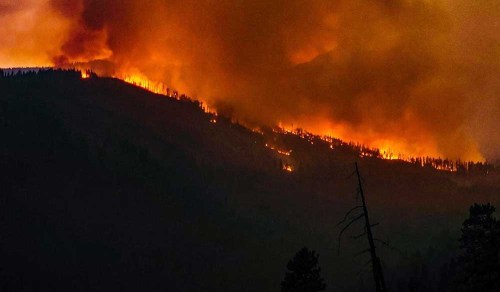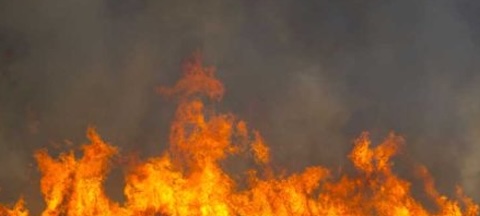Wildfire danger lingers despite cooler, wetter weather
Published 12:30 pm Tuesday, September 22, 2020

- Downed power lines were identified as the cause of 13 fires in the Santiam Canyon during 2020. The prospect of a challenging 2022 fire season in Oregon looms despite a long winter and cold and wet spring.
PORTLAND — A change in weather has slowed the pace of destructive wildfires still burning more than 1 million acres of Oregon, though forecasters say it will likely be weeks before the danger fully subsides.
Westerly onshore winds Sept. 10 brought higher humidity and rain showers that have dampened fires and helped to clear hazardous levels of smoke in the air.
Trending
Eric Wise, a meteorologist at the Northwest Interagency Coordination Center in Portland, said a slow-moving Pacific storm system is expected to reach shore by late Tuesday, Sept. 22.
Despite some timely precipitation, Wise said it would be a mistake to assume the worst of fire season is over. Once the storm system clears, warmer and drier weather is expected to return, keeping forest fuels prime to burn in some areas.
“We’re not quite out of the woods yet,” Wise said.
As of Sept. 21, Oregon had 47 large fires that have burned approximately 1.05 million acres and Washington had 42 large fires that burned 813,594 acres, according to the NWCC. The center defines “large” fires as 100 acres or more in timber and 300 acres or more in grassland.
Jim Gersbach, spokesman for the Oregon Department of Forestry, said each of the agency’s 12 districts remain in fire season, with varying levels of public use restrictions on campfires, smoking and off-road vehicle travel, depending on the local conditions.
Each district decides when to lift restrictions. Historically, fire season can last into mid-October, with seasons starting earlier and ending later in more arid parts of Central and Eastern Oregon.
Trending
“Usually fire season doesn’t end until series of good soaking rains,” Gersbach said. “I would not foresee (officials) ending fire season just yet, even though there is more rain coming this week. There will be drying periods after that, with pretty high temperatures.”
Western Washington will receive the most rainfall from the latest storm system, tapering off as it moves farther south and east, Wise said. Parts of the Oregon and Washington Cascades could get up to 2 inches, with just a quarter-inch or less making its way to south-central and Eastern Oregon.
Tim Klukas, regional fire analyst for the NWCC, said the amount of moisture will affect fire behavior as crews continue working toward containment.
An inch of rain can usually buy 7-10 days of relief by keeping the flames from spreading quickly, Klukas said. More rain is also needed in thicker woods to ensure it reaches beneath the tree canopy and down to heavy, smoldering logs on the forest floor.
“The more that is fully soaked, the more that should put out fire that’s on the ground and keep it isolated to those heavier fuels,” Klukas said.
Overall, Klukas said he believes the weather should allow firefighters to keep more of an even pace with the large blazes. This time of year should also bring less potential for dry lightning, quelling a significant ignition source, he added.
But Klukas cautioned that fine fuels, including dried grass and sagebrush, are still highly flammable and could spread quickly to ignite another large blaze if residents aren’t careful.
“It’s going to stay dry until next spring,” he said. “There is still the need for a lot of precaution.”
Gusty winds from the east amplified large blazes from the coast to the Cascades after Labor Day, which have grown to consume more than 1 million acres in Oregon.
A number of large blazes are still burning across Oregon, though a change in weather has helped firefighters to make progress toward containment.
The following figures are provided by the Northwest Interagency Coordination Center, as of Sept. 21:
• Archie Creek Fire — 131,598 acres, 41% contained. Burning 20 miles east of Glide, Ore. 111 homes destroyed.
• Beachie Creek Fire — 192,736, 38% contained. Started in the Opal Creek Wilderness Area, Willamette National Forest. 470 homes destroyed.
• Echo Mountain Complex — 2,552 acres, 90% contained. Burning 4 miles east of Lincoln City, Ore. 293 homes destroyed.
• Holiday Farm Fire — 173,025 acres, 17% contained. Burning 3 miles west of McKenzie Bridge, Ore. 431 homes destroyed.
• Lionshead Fire — 198,647 acres, 13% contained. Burning 20 miles west of Warm Springs, Ore. 264 homes destroyed.
• Riverside Fire — 137,880 acres, 25% contained. Burning 8 miles southeast of Estacada, Ore. 57 homes destroyed.
• South Obenchain Fire — 32,671 acres, 65% contained. Burning 5 miles east of Eagle Point, Ore. 33 homes destroyed.
• Two Four Two Fire — 14,473 acres, 77% contained. Burning 7 miles east of Fort Klamath, Ore. Eight homes destroyed.









